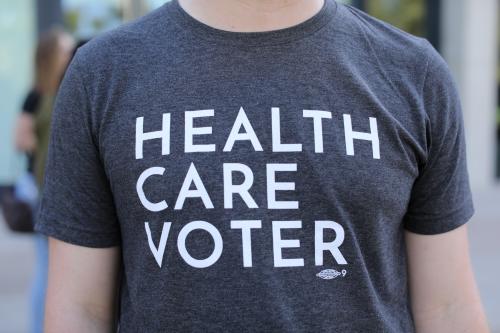The Vitals
Issues in health care policy fall in two broad categories: those related to health care coverage and those related to the underlying cost of health care. Coverage policy addresses where Americans get health insurance, how it is paid for, and what it covers, while policies related to underlying costs seek to reduce overall health care spending by lowering either the price or utilization of health care.
-
Today, about 18% of the Gross Domestic Product is spent on health care, and voters rank health care as a top issue, reflecting the fact that health care is a major expense for many families.
-
Policymakers have very different proposals for how to change coverage. Some proposals would expand the federal role in providing coverage and reduce the number of uninsured, while others would go in the opposite direction.
-
The total amount families and the government spend on health care depends on the underlying cost of care. Policymakers can lower the underlying cost of care by lowering prices or by reducing utilization of services, but doing so can present tradeoffs.
A Closer Look
Health care is a major issue in American politics, with important
debates related to health care coverage and the underlying cost of health care.
The role of health care coverage is
to insulate people from high health care spending burdens and facilitate access
to health care. Policies related to coverage
include those affecting how Americans get health insurance, how that insurance
is paid for, and what insurance does and does not cover. Debates about how to
reduce the number of people without health insurance, whether Americans should
continue to get coverage through their jobs, if health insurance deductibles
are too high, or how to change the premiums required under federal coverage programs
all fall into this category.
Many coverage policies change how much families have to pay for health
care, generally by changing what government programs pay on their behalf or by changing
how health care spending burdens are shared between people with larger and
smaller health care needs. But other proposals aim to reduce the underlying cost of health care, either by reducing how
many health care services patients receive or by reducing the prices paid for
those services. Policies like these have the potential to reduce overall health
care spending throughout the system, but this is often easier said than done.
Policies related to health care coverage
More than 90% of Americans have health insurance. About half get coverage from an employer, and a third get coverage from a government program like Medicare or Medicaid. Another 5% buy coverage on the individual market, while 9% are uninsured. Different policymakers see different problems with the way people get coverage today and, correspondingly, propose different solutions.
Some policymakers believe that current federal programs that provide health care coverage are too generous and inappropriately burden taxpayers. These policymakers often support proposals that would narrow eligibility for or reduce the generosity of those programs, particularly Medicaid and programs that subsidize individual market coverage, even though fewer people would have coverage and some people’s coverage would become less generous. President Trump has supported proposals like these.
Other policymakers are primarily concerned with reducing the number of uninsured or reducing the burdens people face from premiums and cost-sharing. These policymakers often support proposals that would broaden eligibility for existing coverage programs or make those programs more generous, even though it would require additional federal spending. Many Democratic presidential candidates have supported approaches like these. Some proposals focus primarily on people who are currently uninsured or face particularly high health care spending burdens, while others support a program like Medicare for All that would commit a great deal more federal funds and insure all Americans through a single federal program.
Learn more about broad proposals related to health care coverage here. In addition to these broad proposals, some policymakers also support proposals that target specific problems with our existing health insurance system. One example is the fact that people with insurance can sometimes receive large “surprise” bills for health care services, discussed more here.
Policies related to underlying health care costs
Health care spending is
determined by two factors: how many health care services patients receive and
the prices paid for each service. While there is broad agreement that some
health care services are unnecessary and that the prices of some services are
excessive, there is much less agreement about how to address these excesses.
Starting with the volume of
services patients receive, the main challenge policymakers face is discouraging
delivery of services that provide little health benefit without discouraging
delivery of valuable services. One approach is to give health care providers
financial incentives to eliminate unnecessary services by paying them based on
the overall costs their patients incur rather than the number of services they
personally deliver. Reforms
like these can reduce utilization,
seemingly without harming patients’ health, although total savings have been
relatively modest so far.
Another approach is to require
consumers to bear more of the cost of care themselves by increasing
cost-sharing in hopes that they will become more cost-conscious and forgo
low-value services. Research finds that this approach
can also reduce service volume, but consumers often cut back on both high-value
and low-value services rather than just low-value services. Increasing
cost-sharing also reduces the effectiveness of health insurance in protecting
against the costs of illness.
Policymakers may also be
interested in lowering health care prices. A major
cause of excessive prices is that health care provider
markets—particularly hospital markets—are concentrated,
with relatively few competitors in many parts of the country. In addition, many
patients value a broad choice of providers. These and other features of health
care markets allow many providers to demand prices from private insurers that substantially
exceed providers’ costs of delivering health care services.
Policymakers have some options for addressing high prices. One is to make health care markets more competitive. This may include encouraging new entrants, blocking mergers, and aggressively policing anti-competitive behavior. Another approach is to take advantage of the fact that public insurance programs generally pay much lower prices than private insurers by introducing a “public option” or transitioning to a single payer system. Alternatively, policymakers could lower prices by regulating them directly. No matter how policymakers aim to reduce prices, they will need to balance the savings from lower prices against the risk of driving prices too low and jeopardizing access to or quality of care. Prescription drug prices raise somewhat different issues. In most cases, the main reason drugs are expensive is because the government grants a time-limited monopoly to inventors of new drugs via patents and related policies. That monopoly allows manufacturers to set high prices, with the goal of encouraging development of new drugs. Correspondingly, most approaches to lowering prices boil down to reducing the scope or duration of manufacturers’ monopoly or limiting the prices manufacturers can charge while the monopoly lasts. But, here too, there are tradeoffs: the benefits of lower prices on existing drugs must be weighed against the reduction in incentives to develop new drugs.









Commentary
Current debates in health care policy: A brief overview
October 15, 2019